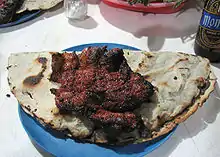Tasajo is a cut of dried beef, normally cooked over a wood fire.
Tasajo in Spain
In Spain, specifically in Toledo, it consists of marinated deer loin that is smoked over a slow fire of holm oak wood, typical of hunting regions.[1]
In the region of La Vera (in the province of Cáceres), and in the neighboring town of Candeleda (in Ávila province),[1] it consists of marinated goat meat that has been macerated and dried. It is usually served as an appetizer in the bars of the area, and it is a good accompaniment with pitarra wine.
Tasajo in Mexico


In Mexican cuisine, tasajo is a cut of beef, typically from the Central Valley of Oaxaca in Oaxaca state. It is similar to pork jerky and is often made with organ meat including that of the head and back, but also can be made with flank[2] or skirt steak.
In the historic quarter of the city of Oaxaca, it is customary to eat tasajo with tlayudas and radishes, as well as with "chiles de agua" and onions. It can also be accompanied with chapulines, quesillo and any other Oaxacan dish.
Tasajo in Panama
In Panama (see Panamanian cuisine), tasajo is a cut of wood smoked beef which is later roasted or fried. It is consumed accompanied by fried food at breakfast or with rice and side dishes at lunch. It is popular in all of the provinces.[3]
Tasajo in Cuba
In Cuba (see Cuban cuisine), jerked beef is most often made from the meat of horses, donkeys, mules, or deer[4] but is prepared similarly to how beef tasajo is prepared. Traditionally, tasajo in Cuba was most often made from horse meat, however, beef tasajo has been a more popular version of late.[5][6][7]
Tasajo in other countries

In Argentina, Brazil and Uruguay, tasajo goes by the name of "Charqui" or "Ch'arki" and consists of dehydrated beef, salted and smoked. Its texture resembles cardboard and was a part of the diet that was provided to enslaved people of African origin until the end of the 19th century in the Antilles and Brazil. The dish is normally prepared by first washing and then rehydrating the dried meat by boiling.
In Venezuela pieces of salted meat are called tasajo or sala.[8]
See also
References
- 1 2 [Díaz Sánchez, Lorenzo (2005). Alianza Editorial, ed. La cocina del Quijote (cuarta edición). Madrid. p. 85. ISBN 84-206-2042-4.]
- ↑ Patijinich.com "Tasajo"
- ↑ Cameron, S.; Box, B. (1999). Mexico & Central America Handbook. Footprint Central America Handbook (in Italian). Footprint Handbooks. p. 1168. ISBN 978-0-8442-4838-7. Retrieved October 17, 2018.
- ↑ blog.vacuba.com "Tasajo Cubano"
- ↑ Icuban.com Tasajo
- ↑ CubaCuban.com "Tasajo"
- ↑ Cibercuba.com "Aporreado de Tasajo"
- ↑ [Fogones y Cocinas tradicionales de Venezuela. Caracas: Ediciones Cavendes. 1993.]